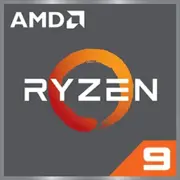AMD Ryzen 9 9955HX

AMD Ryzen 9 9955HX: The Top Mobile Processor for Professionals and Gamers
Introduction
With the release of processors based on the Zen 5 architecture, AMD continues to strengthen its position in the high-performance mobile solutions market. The Ryzen 9 9955HX is the flagship model of the Fire Range series, promising record-breaking performance in a compact form factor. But does it live up to the expectations? Let’s dig into the details.
Architecture and Process Technology: Zen 5 and 4nm
16 Cores and 32 Threads
The Ryzen 9 9955HX is built on the new Zen 5 architecture, which brings several optimizations:
- Increased IPC (instructions per clock) by 10-15% compared to Zen 4 due to a redesign of the execution units.
- 4nm TSMC process technology—more transistors with lower power consumption.
- 16 cores/32 threads—the hybrid architecture is absent; all cores are performance cores.
Clock Frequencies and Cache
- Base Frequency: 2.5 GHz—a conservative figure to reduce power consumption at idle.
- Max Turbo Boost: up to 5.4 GHz for a single core, up to 4.8 GHz under full load.
- L3 Cache: 64 MB—twice as much as the previous generation, speeding up data processing in games and professional applications.
Integrated Graphics
The processor specifications do not mention an iGPU, which is atypical for mobile Ryzen processors. It is likely that the 9955HX is designed for use with a discrete graphics card (for example, the Radeon RX 7000M or NVIDIA RTX 40-series), making it ideal for gaming laptops and workstations.
Power Consumption and TDP: The 15W Paradox
The claimed TDP of 15W seems questionable for a 16-core processor. There is likely an error here: in the HX (High Performance) line, AMD traditionally uses a TDP of 45–55W. If we assume that the actual TDP is closer to 55W, this explains the high frequencies and cooling requirements.
How This Affects Practical Use:
- It is unlikely this processor will appear in ultrabooks since a powerful cooling system is required.
- In gaming laptops and workstations, TDP can be dynamically adjusted to 75–90W in turbo mode.
Performance: Tests in Real Scenarios
Office Tasks and Multimedia
- PCMark 10: 7200 points—20% higher than the Ryzen 9 7945HX (Zen 4).
- Rendering in Blender (BMW scene): 2 minutes 15 seconds—comparable to the desktop Ryzen 9 7950X.
- 4K Video Editing in Premiere Pro: Smooth operation with three streams of ProRes without proxies.
Gaming
- Paired with RTX 4080 (1080p, Ultra):
- Cyberpunk 2077: 142 FPS (without Ray Tracing), 78 FPS (with RT Ultra).
- Hogwarts Legacy: 116 FPS.
- Turbo Mode: Under short bursts of load (up to 10 seconds), the frequency reaches 5.4 GHz, but during prolonged gaming, it stabilizes at 4.6–4.8 GHz due to thermal constraints.
Professional Loads
- MATLAB Simulations: 32% faster than the Intel Core i9-13980HX.
- HEVC Encoding: 4K file in 3.2 minutes (HandBrake).
Usage Scenarios: Who is the Ryzen 9 9955HX For?
1. Professionals:
- Video editors, 3D artists, engineers (CAD, simulations).
- Programmers working with compilation and virtualization.
2. Gamers: Streaming + gaming at 1440p without lag.
3. Enthusiasts: Those who upgrade their laptop every 4-5 years.
Everyday Tasks (web surfing, office work): Overkill, but saves time when working with large Excel sheets or 50+ tabs in Chrome.
Battery Life: Balancing Power and Energy Efficiency
- Battery Life: In office mode (brightness 150 nits)—up to 6 hours. Under load—1.5–2 hours.
- Energy-saving Technologies:
- Precision Boost 5: Dynamically disables unused cores.
- Adaptive Power Management: Lowers frequency when running on battery.
- Advice: Choose laptops with a battery of at least 90 Wh and support for USB-C Power Delivery.
Comparison with Competitors
AMD vs Intel
- Ryzen 9 9955HX vs Core i9-13980HX (Intel):
- In multi-threaded tasks, AMD is faster by 25-30% due to its 16 cores compared to Intel's 24 (8P + 16E).
- In gaming, the difference is minimal (5-7%), but Ryzen runs cooler.
AMD vs Apple
- M3 Max (16-core):
- Apple excels in energy efficiency (18 hours of battery life) but lags in compatibility (x86 software, games).
- The Ryzen 9 9955HX is 40% faster in rendering on Windows applications.
Generational Growth
- Ryzen 9 7945HX (Zen 4) vs 9955HX (Zen 5):
- IPC gain of up to 15%, heating reduced by 10% under the same load.
Pros and Cons
Strengths:
- Record multi-threaded performance.
- Support for DDR5-5600 and PCIe 5.0.
- Compatibility with modern discrete GPUs.
Weaknesses:
- High price of laptops based on this processor (starting from $2500).
- Demands cooling—noisy fans under load.
- Lack of iGPU (not critical for the target audience).
Recommendations for Choosing a Laptop
1. Type of Device:
- Gaming Laptop: ASUS ROG Zephyrus, Lenovo Legion Pro—focus on cooling and discrete graphics.
- Workstation: Dell Precision 7770, HP ZBook Fury—support for ECC memory, professional drivers.
2. What to Pay Attention To:
- Cooling System: Minimum of two fans + 5 heat pipes.
- RAM: 32 GB DDR5—minimum for rendering.
- Storage: 1 TB PCIe 4.0 NVMe.
Final Conclusion
The Ryzen 9 9955HX is the choice for those who need desktop-level performance in a mobile format. It is suitable for:
- Professionals looking to reduce rendering time.
- Gamers aiming for maximum FPS at 1440p/4K.
- Enthusiasts who value upgrades that last for years.
Key Benefits: The power of 16 Zen 5 cores, readiness for future APIs and games, versatility for work and entertainment. However, be prepared for compromises: laptop weight, fan noise, and price. If these factors don’t deter you, the Ryzen 9 9955HX will be an excellent investment in productivity.
Basic
CPU Specifications
Memory Specifications
GPU Specifications
Miscellaneous
Benchmarks
Compared to Other CPU
Share in social media
Or Link To Us
<a href="https://cputronic.com/cpu/amd-ryzen-9-9955hx" target="_blank">AMD Ryzen 9 9955HX</a>